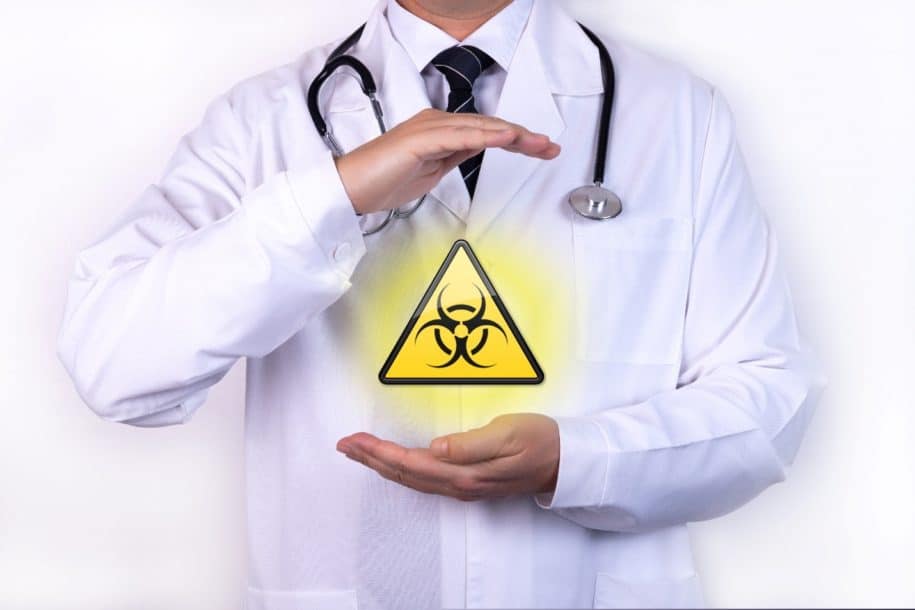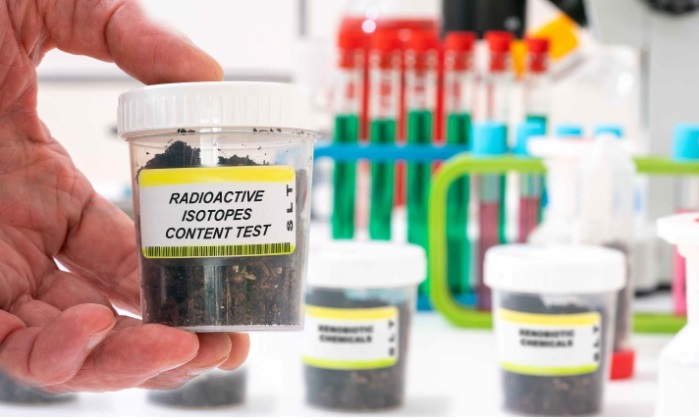We’re all exposed to radiation each day. Some sources of this radiation, like microwaves and sunlight, are relatively harmless and an everyday part of life. Others, like alpha and beta particles, are hazardous and potentially life-threatening. Workers employed in the manufacturing, nuclear energy, food processing, and medical fields can be exposed to significant amounts of radiation each day. To shield them from the harmful effects of this radiation, their employers need to adopt a viable radiation safety program. But what exactly is radiation safety and how can it be adopted in the workplace? Before we can answer this question, we first need to understand what radiation is and why its ionizing variant is so lethal to humans.
What is radiation?
Radiation is the name given to the transmission of energy by way of waves or particles. Energy is emitted by one body and travels through space or a medium before it is absorbed by another body. Radiation is generally classified into two types based on the effects it has on its recipient: non-ionizing and ionizing radiation.
- Non-ionizing radiation includes radio waves, microwaves, infrared light, visible light, and ultraviolet light. This type of radiation generally poses little danger to humans unless exposure is in large or concentrated doses. Too much ultraviolet light (UV-A), for example, can cause melanoma and non-melanoma skin cancers.
- Ionizing radiation includes X-rays, cosmic rays, and radiation stemming from radioactive materials. Ionizing radiation is dangerous because it destabilizes molecules in the tissues and cells, leading to organ failure, acute radiation syndrome (also known as radiation sickness), and in severe cases, death.
What is radiation safety?
Radiation safety (also known as radiation protection) is defined by the International Atomic Energy Agency (IAEA) as “the protection of people from [the] harmful effects of exposure to ionizing radiation, and the means for achieving this.” While focused on maintaining the appropriate level of protection for humans, animals, and the environment, radiation safety also seeks to harness the advantages of ionizing radiation. When harnessed correctly, ionizing radiation provides many benefits to a wide variety of industries—including the medical, food processing, aerospace, and energy industries. Without the proper safety measures, however, exposure to dangerous levels of ionizing radiation could lead to acute health effects, including skin burns, radiation sickness, cardiovascular disease, and cancer, according to the Environmental Protection Agency (EPA).
Why is radiation safety important in the workplace?
In job environments where workers are exposed to varying levels of ionizing radiation, radiation safety measures are mandated by the Occupational Safety and Health Administration (OSHA). An important guideline for workplace radiation safety is ALARA—which is an acronym that stands for “As Low As Reasonably Achievable.” The focus of ALARA is to keep each worker’s occupational radiation exposure as far below the federal and state regulatory dosage limits as possible. Well-planned radiation safety—together with a radiation protection program—helps employers create a hazard-free zone where the optimal prevention measures are enforced. This safeguards all workers from the harmful effects of ionizing radiation.
What are the potential sources of radiation exposure in the workplace?
As radiation is harnessed by such a wide variety of industries, there are numerous potential sources of radiation exposure in these workplaces.
Listed here are just some of the potential sources of occupational radiation exposure:
- Aerospace industry– Astronauts on missions are regularly exposed to dangerous levels of ionizing radiation. An astronaut on a six-month mission to the International Space Station is exposed to approximately 50 to 2,000 millisieverts (mSv). This unit of measurement is used to monitor the impact of low levels of ionizing radiation on the human body. The risk of developing cancer due to ionizing radiation exposure begins at 100mSv.
- Medical industry– Both patients and medical professionals are exposed to ionizing radiation through X-ray machines, radiotherapy, and some radioactive chemicals used in cancer treatment.
- Food processing industry– Food irradiation is the practice of applying ionizing radiation to food. This is done to extend the shelf life of food by reducing or eliminating insects and microorganisms. Unless workers are safeguarded by personal protective equipment (PPE) and workplace safety measures, they could be exposing themselves to dangerous levels of ionizing radiation.
- Nuclear industry– As both the Fukushima and Chernobyl nuclear disasters have proven, the radioactive materials found in nuclear reactors pose serious dangers to humans, animals, and the environment.
- Academia– Many labs in university and postsecondary labs use radiation-emitting devices, and/or perform research on radioactive materials. With improper safety protocols in place, these types of devices and research can lead to potential radiation safety issues in the realm of higher education.
- Oil and gas industry– The process of drilling and extracting oil and gas, including fracking, has the potential of releasing radioactive materials into the environment, which is a hazard that oil and gas companies cannot afford to ignore.
- Pharmaceutical research and development industry– Some pharmaceutical companies use radiation-emitting devices to sterilize their products, devices, etc. Proper radiation handling protocols in pharmaceutical research laboratories are a necessity.
3 ways to improve radiation safety in the workplace.
Now that we’ve gone over the potential hazards and benefits of ionizing radiation, let’s look at the various ways radiation safety can be improved in the workplace.
1. Create and implement a radiation protection program.
A radiation protection program is designed to protect workers from the effects of ionizing radiation. These programs are usually managed by a radiation safety officer (RSO). Aside from creating and managing the radiation protection policies and procedures, the RSO will also take charge of all radiation safety training, conduct workplace safety inspections and observations, and implement a dosimetry program. Dosimetry programs use dosimeters to measure radiation levels on a cumulative basis and will warn the RSO if specific thresholds are reached.
OSHA also recommends creating a radiation safety committee to guide the radiation protection program. This committee will consist of the RSO, executives and managers, and key rank-and-file workers. The ultimate goal is to improve radiation safety by spotting any weaknesses in the existing program, as well as encouraging workers to report any at-risk behaviors observed at the job site.
2. Access a radiation safety EH&S solution.
Part of SafetyStratus’ cloud-based EH&S platform, the Radiation Safety Module provides cradle-to-grave radiation safety management assistance by facilitating the safe disposal of radioactive materials and hazardous equipment to prevent radioactive contamination. The SafetyStratus Radiation Safety Module covers all key areas associated with radioactive waste management and disposal—including licenses, permits, orders, inventory, and training.
3. Wear appropriate personal protective equipment.
To prevent workers from becoming contaminated with radioactive material, they should always (correctly!) wear job-appropriate personal protective equipment. PPE prevents skin contamination from particulate radiation (both alpha and beta) and the inhalation of hazardous radioactive materials. To maximize safety, workers should always review the radioactive materials that the PPE is designed to protect against. Workers knowing why a process is helpful to them is a way to guarantee better participation in required safety measures.
- Radiation protection suits– These are designed to safeguard the wearer from radiation hazards. These include alpha and beta particles, as well as X-ray and gamma-ray radiation.
- Radiation safety glasses– This form of leaded eyewear is designed to protect the wearer’s eyes when exposed to harmful radiation.
- Lead aprons and vests– These are designed to reduce the wearer’s radiation dose.
All these forms of PPE should be fitted to the individual and include training for proper wear, to ensure maximum protection.
Safety training plays a critical role in radiation safety.
In environments that expose workers to varying doses of ionizing radiation, regular safety training is vital to creating a hazard-free work environment. The radiation safety officer should teach supervisors and workers how to maintain a safe distance from the radioactive source, limit their time around this source, and properly use PPE to prevent contamination.
While ionizing radiation has its dangers, when harnessed responsibly with the assistance of an effective radiation safety program, it can provide numerous benefits to society.
Author Bio
The SafetyStratus Research Advisory Group (RAG) brings together thought leaders from the global environmental, health, and safety community to promote best practices and provide key insights in the profession and the industries they serve. The Research Advisory Group also advocates, where practical, the intersection of and advances with the use of technology, such as the SafetyStratus enterprise EHS software platform. Group membership consists of representatives from across varied disciplines and market sectors as well as select members of the SafetyStratus team.
The primary objectives of the SafetyStratus RAG partnership are to:
- Build a strategic partnership between EHS practitioners and the SafetyStratus team.
- Provide engaging and practical content to the global EHS community.
- Provide discipline and market feedback specific to SafetyStratus products and services.
While the objectives of the RAG are varied, the primary public-facing outcome will be available through engaging and practical content found on the SafetyStratus resource pages. Various articles, papers, and other valuable resources will be produced and shared as part of an ongoing effort to cultivate a robust community. Ultimately, the SafetyStratus RAG will expand to have a broader reach and provide opportunities for more inclusion by all interested EHS professionals in a collaborative community environment.


